选择性必修二 Unit3 Food and Culture-Reading andThinking (39张PPT)
文档属性
| 名称 | 选择性必修二 Unit3 Food and Culture-Reading andThinking (39张PPT) | 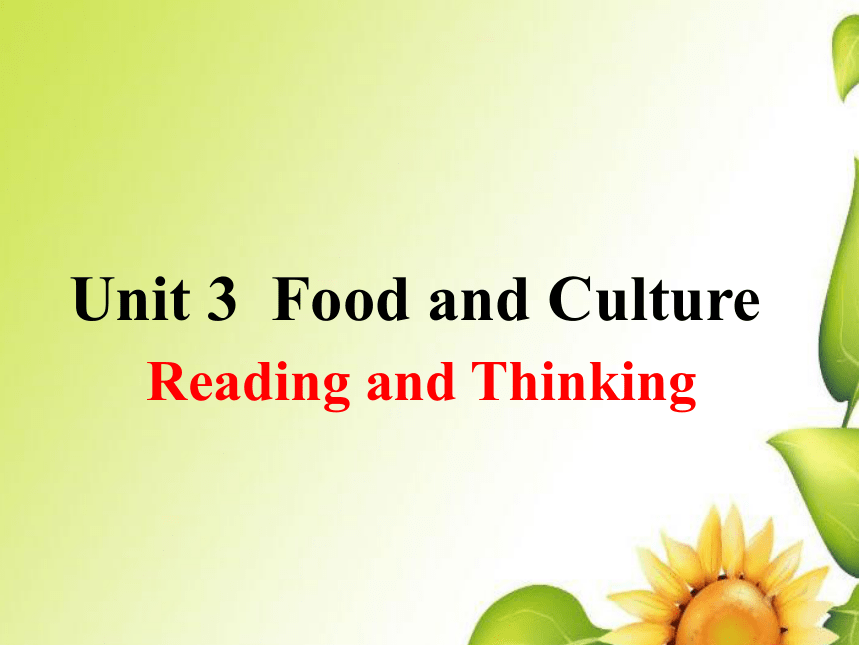 | |
| 格式 | zip | ||
| 文件大小 | 1.5MB | ||
| 资源类型 | 试卷 | ||
| 版本资源 | 人教版(2019) | ||
| 科目 | 英语 | ||
| 更新时间 | 2021-12-30 19:44:31 | ||
图片预览

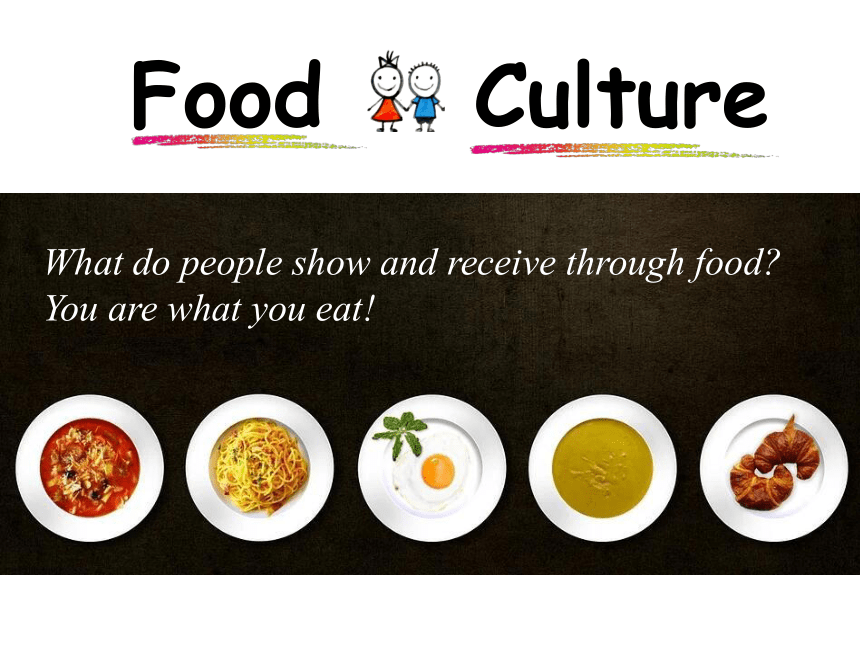
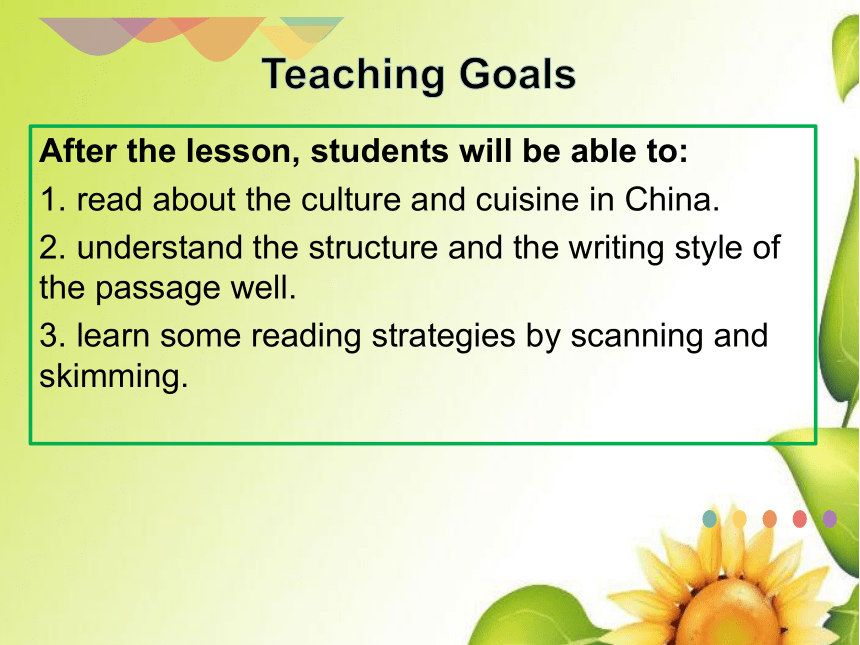
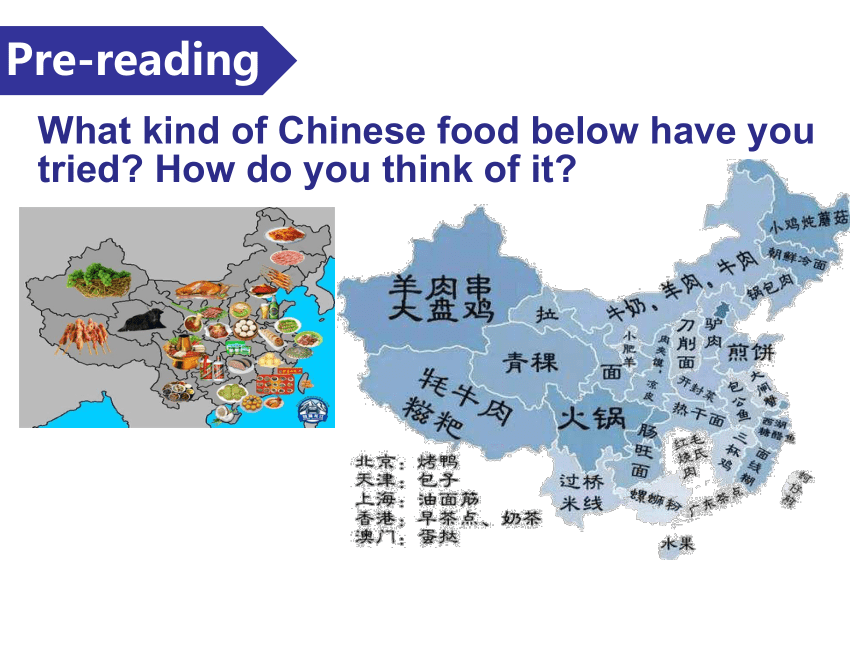
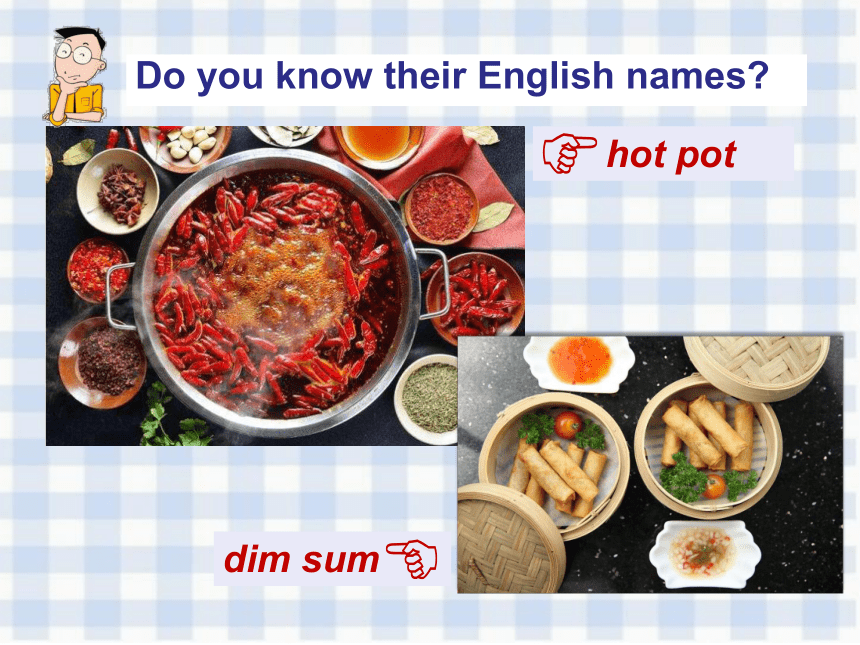
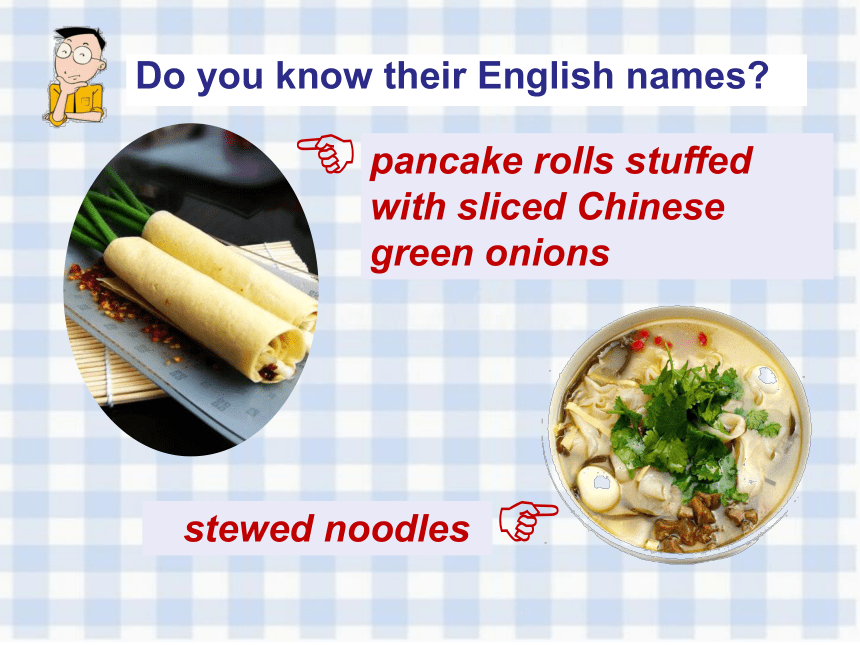
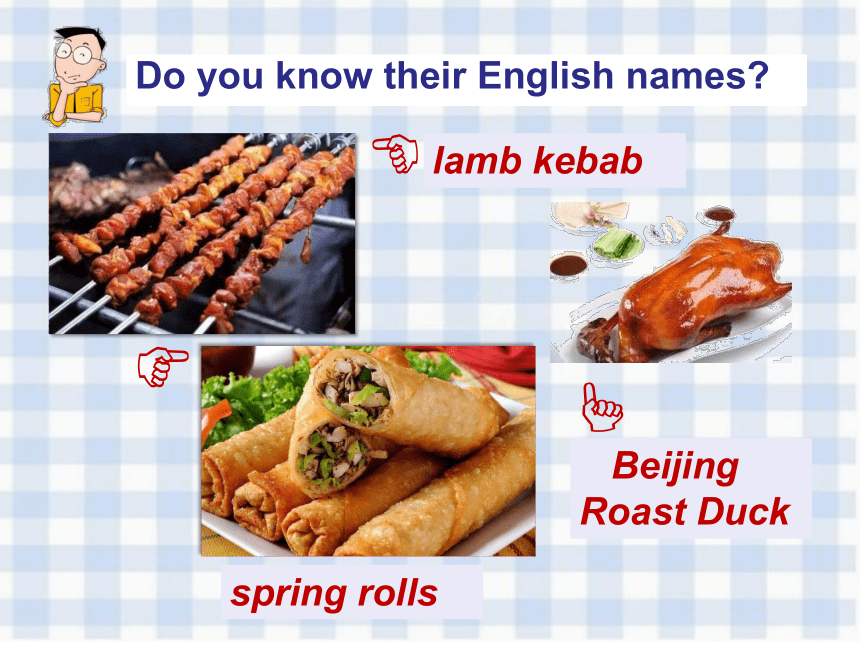
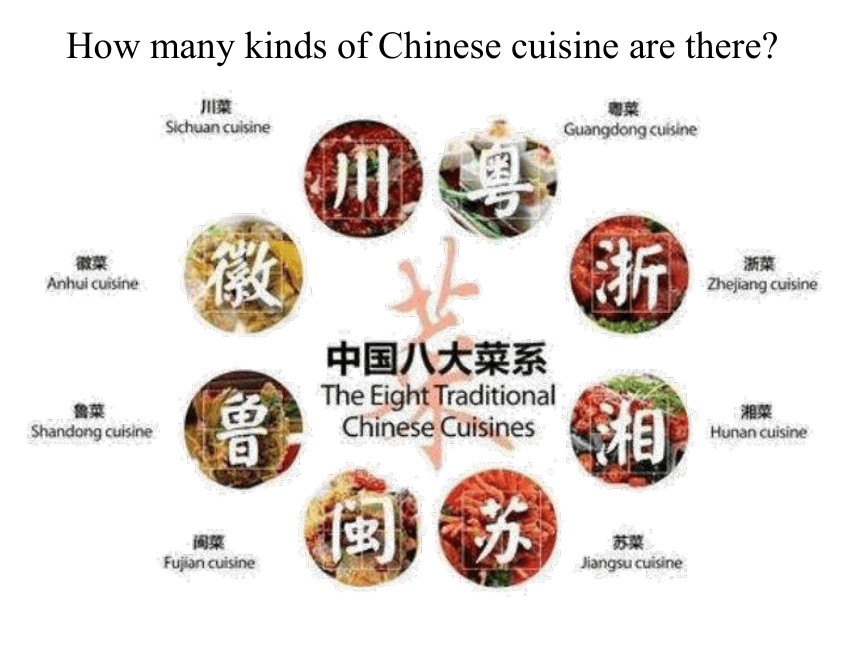
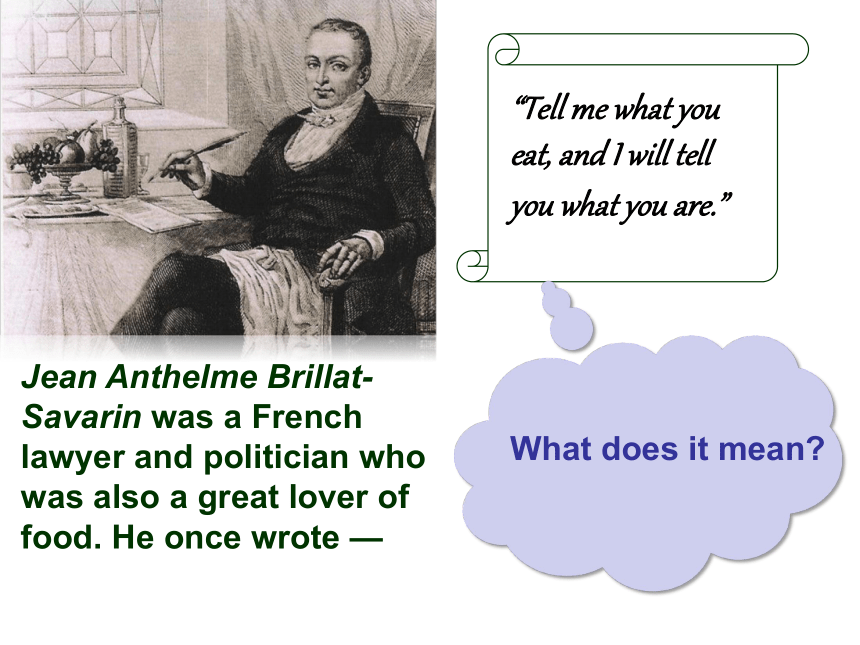
文档简介
(共29张PPT)
Unit 3 Food and Culture
Reading and Thinking
Food
Culture
What do people show and receive through food
You are what you eat!
After the lesson, students will be able to:
1. read about the culture and cuisine in China.
2. understand the structure and the writing style of the passage well.
3. learn some reading strategies by scanning and skimming.
Teaching Goals
What kind of Chinese food below have you tried How do you think of it
Pre-reading
Do you know their English names
hot pot
dim sum
Do you know their English names
stewed noodles
pancake rolls stuffed with sliced Chinese green onions
Do you know their English names
lamb kebab
Beijing Roast Duck
spring rolls
How many kinds of Chinese cuisine are there
Jean Anthelme Brillat-Savarin was a French lawyer and politician who was also a great lover of food. He once wrote —
“Tell me what you
eat, and I will tell
you what you are.”
What does it mean
Read the article to see if you share the same ideas as the author.
While-reading
Read the text and find out the answers to the following questions.
1.What does the dish General Tso’s chicken tell about Americans
2.What impressed the writer most while in Beijing
3.What did the writer find is important to people in China while he was in Shandong
4.Why did people in Xinjiang enjoy cooking over an open fire
5.What does elegant dim sum mean
6.What does the food local people consume tell the writer
keys
1.What does the dish General Tso’s chicken tell about Americans
It tells people that Americans love bold, simple flavors and are not afraid to try new foods.
2.What impressed the writer most while in Beijing
The friendship offered by people.
3.What did the writer find is important to people in China while he was in Shandong
Family.
keys
4.Why did people in Xinjiang enjoy cooking over an open fire
They traditionally wandered the open range on horses.
5.What does elegant dim sum mean
Small servings of food in bamboo steamers.
6.What does the food local people consume tell the writer
It tells us what people grow in their region and what kinds of lives they lead, what they like or dislike.
1. “You are what you eat.” What does this saying
mean
The saying means that the kind of food we eat tells something about our personality, character, and culture.
Additional questions to understand the structure:
2. Which is the topic paragraph
3. Which is the topic sentence
The first and the last paragraphs.
What we say, however, is that culture and cuisine go hand in hand, and if you do not experience one, you can never really know the other.
Make a mind map for the structure.
Topic: You are what you eat.
Chinese food in America
Chinese food in Beijing
Chinese food in Shandong
Chinese food in Xinjiang
Chinese food in GD & HN
Conclusion: Culture and cuisine go hand in hand.
Use the information from the text to complete the table below.
Place Kind of Chinese food Typical dish People or culture
America
Beijing
Shandong
Chinese food changed to suit American tastes
General Tso's chicken
Americans love bold, simple flavours, and are not afraid to try new foods.
Sichan cuisine
dishes with Sichuan peppercorns
People there offered them good friendship.
Shandong cuisine
boiled dumplings served with vinegar; pancake rolls stuffed with sliced Chinese green onions
Family is important to the people there.
Place Kind of Chinese food Typical dish People or culture
Northwest China
South China
Central China
Xinjiang and Inner Mongolian cuisine
boiled or roasted meat, such as lamb kebab
People there traditionally wandered the open range on horses so their traditional foods are what you can cook over an open fire.
Guangdong cuisine
dim sum
Henan cuisine
stewed noodles
Through food, Chinese people everywhere show friendship and kindness.
Food
Different places
Culture
① People live in different places, so they share
different local cultures.
② They share different local cultures, as a result,
they have different kinds of food.
Reasoning and Analysis
What is the relationship between them (cause/effect)
cause
effect
cause
effect
Understand cause and effect
Sometimes two ideas are related to each other by cause and effect. That is, one thing causes something else to happen. Cause-and-effect
relationships can be direct. For example,“It was raining, so I took my umbrella.”However, some cause-and-effect relationships are not direct, and some may also have more than one cause or effect.
Match the causes to the effects below. Then find more examples from the text.
Cause
1 The flavour preferences of Americans often
differ from those of the Chinese.
2 We had no idea how to order food.
3 These groups traditionally wandered the open
range on horses.
Effect
A The chef just began filling our table with the best
food we had ever eaten.
B Their traditional foods are what you can cook
over an open fire.
C Chinese food in America is changed to suit
American tastes.
Keys:
1. C 2. A 3. B
Who is the clever spy
Teachers provide questions to each group.
Students can discuss with group members and find out the "cause-and-effect"answers.
The first finished group is the clever spy.
Post-reading
Discuss in groups
1. Do you think “culture and cuisine go hand in
hand” Give your reasons.
Yes, because so much of a culture is based upon food and how it is eaten and served.
No, with the impact of globalization, food no longer reflects cultures. In this fast-changing world, everything is changing, including cuisines.
2. Imagine that it is true that people's
personalities are closely linked to the foods
they eat. What does eating the following foods
tell you about a person
spicy food vegetarian food junk food seafood
sweets chocolate rice noodles onion garlic
bacon ham sausage cabbage mushroom
bean curd
Possibly, people who like spicy food love excitement and new experiences. And people who like junk food like to enjoy life without worrying about the future.
Find words from the reading passage which
have similar meaning to the words in italics.
Build up your vocabulary
1
1. We'll need ten months at least to have the
restaurant decorated.
2. Some traditional Chinese dishes from before the
Ming Dynasty are still popular today.
3. My grandpa's breakfast mainly includes
wholegrain biscuits and a glass of milk.
at a minimum
prior to
consists of
Find words from the reading passage which
have similar meaning to the words in italics.
Build up your vocabulary
1
4. People in this area would eat nearly a kilo of
cheese per week.
5. We enjoyed a special dinner in a fancy restaurant
where the waiters all wore attractive suits.
6. He prefers this brand of coffee which, as he said,
has an unusually good flavour.
consume
elegant
exceptional
Learn more about foods around the world by matching the first and second halves of the following sentences.
2
1. Italy, Greece, and
Spain are famous
for their olives, figs,
and other ingredients,
2. She sliced off
3. A traditional Western
dinner can consist of
A. a piece of sausage for
her dinner.
B. an appetiser, a main
course, soup, and
dessert.
C. which have all
contributed to centuries
of cuisine development.
Language points
prior to
put more simply
consist of
have a chance to do
recommend sb to do
make dumplings
slice …off
over an open fire
dim sum
at a minimum
tend to do
之前
把更多的只是
由…构成
有机会做吗
推荐某人做某事
包饺子
切去……
在篝火上
点心
至少
倾向于做
Translation Exercises
1. 川菜麻辣浓香,京菜味重香浓,粤菜香脆清淡,沪菜油多味甜。
2. 说起中餐,人们都知道中餐烹饪以其“色、香、味、形”俱全著称于世。中国悠久的历史、广袤的疆土、好客的习俗,这些都孕育了中餐烹饪的独特艺术。中餐烹饪讲究原料的选配、食物的质地、佐料的调制、切菜的刀功、适时的烹饪,以及装盘艺术。最负盛名的中餐菜系有南方的粤菜、北方的鲁菜、东部的淮扬菜和西部的川菜,素有“南淡北咸,东甜西辣”之特点。
1. 川菜麻辣浓香,京菜味重香浓,粤菜香脆清淡,沪菜油多味甜。
Sichuan cuisine is hot and spicy, Beijing cuisine is heavy and fragrant, Cantonese cuisine is crisp and light, and Shanghai cuisine is sweet with many flavors.
2. 说起中餐,人们都知道中餐烹饪以其“色、香、味、形”俱全著称于世。中国悠久的历史、广袤的疆土、好客的习俗,这些都孕育了中餐烹饪的独特艺术。
Speaking of Chinese food, it is universally acknowledged that Chinese cuisine is world-famous for its perfect combination of color, aroma, taste and appearance. China's long history, vast territory and hospitable customs have given birth to the unique art of Chinese cooking.
中餐烹饪讲究原料的选配、食物的质地、佐料的调制、切菜的刀功、适时的烹饪,以及装盘艺术。最负盛名的中餐菜系有南方的粤菜、北方的鲁菜、东部的淮扬菜和西部的川菜,素有“南淡北咸,东甜西辣”之特点。
Chinese cooking focuses on the selection of raw materials, the texture of food, the blending of seasonings, the cutting of dishes, the timely cooking, and the art of serving. The most famous Chinese cuisines are the Cantonese cuisine in the south, the Shandong cuisine in the north, the Huaiyang cuisine in the east and the Sichuan cuisine in the west, known as "south light north salty, east sweet west spicy" characteristics.
Unit 3 Food and Culture
Reading and Thinking
Food
Culture
What do people show and receive through food
You are what you eat!
After the lesson, students will be able to:
1. read about the culture and cuisine in China.
2. understand the structure and the writing style of the passage well.
3. learn some reading strategies by scanning and skimming.
Teaching Goals
What kind of Chinese food below have you tried How do you think of it
Pre-reading
Do you know their English names
hot pot
dim sum
Do you know their English names
stewed noodles
pancake rolls stuffed with sliced Chinese green onions
Do you know their English names
lamb kebab
Beijing Roast Duck
spring rolls
How many kinds of Chinese cuisine are there
Jean Anthelme Brillat-Savarin was a French lawyer and politician who was also a great lover of food. He once wrote —
“Tell me what you
eat, and I will tell
you what you are.”
What does it mean
Read the article to see if you share the same ideas as the author.
While-reading
Read the text and find out the answers to the following questions.
1.What does the dish General Tso’s chicken tell about Americans
2.What impressed the writer most while in Beijing
3.What did the writer find is important to people in China while he was in Shandong
4.Why did people in Xinjiang enjoy cooking over an open fire
5.What does elegant dim sum mean
6.What does the food local people consume tell the writer
keys
1.What does the dish General Tso’s chicken tell about Americans
It tells people that Americans love bold, simple flavors and are not afraid to try new foods.
2.What impressed the writer most while in Beijing
The friendship offered by people.
3.What did the writer find is important to people in China while he was in Shandong
Family.
keys
4.Why did people in Xinjiang enjoy cooking over an open fire
They traditionally wandered the open range on horses.
5.What does elegant dim sum mean
Small servings of food in bamboo steamers.
6.What does the food local people consume tell the writer
It tells us what people grow in their region and what kinds of lives they lead, what they like or dislike.
1. “You are what you eat.” What does this saying
mean
The saying means that the kind of food we eat tells something about our personality, character, and culture.
Additional questions to understand the structure:
2. Which is the topic paragraph
3. Which is the topic sentence
The first and the last paragraphs.
What we say, however, is that culture and cuisine go hand in hand, and if you do not experience one, you can never really know the other.
Make a mind map for the structure.
Topic: You are what you eat.
Chinese food in America
Chinese food in Beijing
Chinese food in Shandong
Chinese food in Xinjiang
Chinese food in GD & HN
Conclusion: Culture and cuisine go hand in hand.
Use the information from the text to complete the table below.
Place Kind of Chinese food Typical dish People or culture
America
Beijing
Shandong
Chinese food changed to suit American tastes
General Tso's chicken
Americans love bold, simple flavours, and are not afraid to try new foods.
Sichan cuisine
dishes with Sichuan peppercorns
People there offered them good friendship.
Shandong cuisine
boiled dumplings served with vinegar; pancake rolls stuffed with sliced Chinese green onions
Family is important to the people there.
Place Kind of Chinese food Typical dish People or culture
Northwest China
South China
Central China
Xinjiang and Inner Mongolian cuisine
boiled or roasted meat, such as lamb kebab
People there traditionally wandered the open range on horses so their traditional foods are what you can cook over an open fire.
Guangdong cuisine
dim sum
Henan cuisine
stewed noodles
Through food, Chinese people everywhere show friendship and kindness.
Food
Different places
Culture
① People live in different places, so they share
different local cultures.
② They share different local cultures, as a result,
they have different kinds of food.
Reasoning and Analysis
What is the relationship between them (cause/effect)
cause
effect
cause
effect
Understand cause and effect
Sometimes two ideas are related to each other by cause and effect. That is, one thing causes something else to happen. Cause-and-effect
relationships can be direct. For example,“It was raining, so I took my umbrella.”However, some cause-and-effect relationships are not direct, and some may also have more than one cause or effect.
Match the causes to the effects below. Then find more examples from the text.
Cause
1 The flavour preferences of Americans often
differ from those of the Chinese.
2 We had no idea how to order food.
3 These groups traditionally wandered the open
range on horses.
Effect
A The chef just began filling our table with the best
food we had ever eaten.
B Their traditional foods are what you can cook
over an open fire.
C Chinese food in America is changed to suit
American tastes.
Keys:
1. C 2. A 3. B
Who is the clever spy
Teachers provide questions to each group.
Students can discuss with group members and find out the "cause-and-effect"answers.
The first finished group is the clever spy.
Post-reading
Discuss in groups
1. Do you think “culture and cuisine go hand in
hand” Give your reasons.
Yes, because so much of a culture is based upon food and how it is eaten and served.
No, with the impact of globalization, food no longer reflects cultures. In this fast-changing world, everything is changing, including cuisines.
2. Imagine that it is true that people's
personalities are closely linked to the foods
they eat. What does eating the following foods
tell you about a person
spicy food vegetarian food junk food seafood
sweets chocolate rice noodles onion garlic
bacon ham sausage cabbage mushroom
bean curd
Possibly, people who like spicy food love excitement and new experiences. And people who like junk food like to enjoy life without worrying about the future.
Find words from the reading passage which
have similar meaning to the words in italics.
Build up your vocabulary
1
1. We'll need ten months at least to have the
restaurant decorated.
2. Some traditional Chinese dishes from before the
Ming Dynasty are still popular today.
3. My grandpa's breakfast mainly includes
wholegrain biscuits and a glass of milk.
at a minimum
prior to
consists of
Find words from the reading passage which
have similar meaning to the words in italics.
Build up your vocabulary
1
4. People in this area would eat nearly a kilo of
cheese per week.
5. We enjoyed a special dinner in a fancy restaurant
where the waiters all wore attractive suits.
6. He prefers this brand of coffee which, as he said,
has an unusually good flavour.
consume
elegant
exceptional
Learn more about foods around the world by matching the first and second halves of the following sentences.
2
1. Italy, Greece, and
Spain are famous
for their olives, figs,
and other ingredients,
2. She sliced off
3. A traditional Western
dinner can consist of
A. a piece of sausage for
her dinner.
B. an appetiser, a main
course, soup, and
dessert.
C. which have all
contributed to centuries
of cuisine development.
Language points
prior to
put more simply
consist of
have a chance to do
recommend sb to do
make dumplings
slice …off
over an open fire
dim sum
at a minimum
tend to do
之前
把更多的只是
由…构成
有机会做吗
推荐某人做某事
包饺子
切去……
在篝火上
点心
至少
倾向于做
Translation Exercises
1. 川菜麻辣浓香,京菜味重香浓,粤菜香脆清淡,沪菜油多味甜。
2. 说起中餐,人们都知道中餐烹饪以其“色、香、味、形”俱全著称于世。中国悠久的历史、广袤的疆土、好客的习俗,这些都孕育了中餐烹饪的独特艺术。中餐烹饪讲究原料的选配、食物的质地、佐料的调制、切菜的刀功、适时的烹饪,以及装盘艺术。最负盛名的中餐菜系有南方的粤菜、北方的鲁菜、东部的淮扬菜和西部的川菜,素有“南淡北咸,东甜西辣”之特点。
1. 川菜麻辣浓香,京菜味重香浓,粤菜香脆清淡,沪菜油多味甜。
Sichuan cuisine is hot and spicy, Beijing cuisine is heavy and fragrant, Cantonese cuisine is crisp and light, and Shanghai cuisine is sweet with many flavors.
2. 说起中餐,人们都知道中餐烹饪以其“色、香、味、形”俱全著称于世。中国悠久的历史、广袤的疆土、好客的习俗,这些都孕育了中餐烹饪的独特艺术。
Speaking of Chinese food, it is universally acknowledged that Chinese cuisine is world-famous for its perfect combination of color, aroma, taste and appearance. China's long history, vast territory and hospitable customs have given birth to the unique art of Chinese cooking.
中餐烹饪讲究原料的选配、食物的质地、佐料的调制、切菜的刀功、适时的烹饪,以及装盘艺术。最负盛名的中餐菜系有南方的粤菜、北方的鲁菜、东部的淮扬菜和西部的川菜,素有“南淡北咸,东甜西辣”之特点。
Chinese cooking focuses on the selection of raw materials, the texture of food, the blending of seasonings, the cutting of dishes, the timely cooking, and the art of serving. The most famous Chinese cuisines are the Cantonese cuisine in the south, the Shandong cuisine in the north, the Huaiyang cuisine in the east and the Sichuan cuisine in the west, known as "south light north salty, east sweet west spicy" characteristics.
